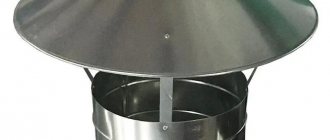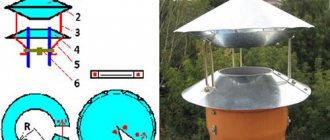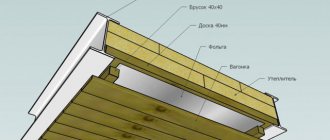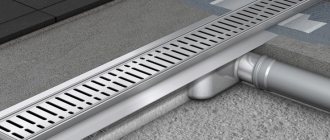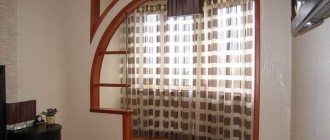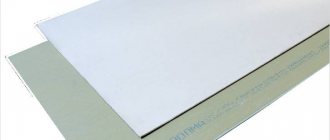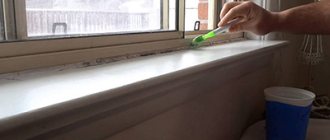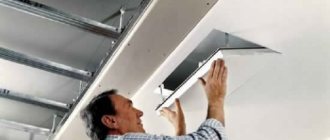Additional elements for roofing are represented, in most cases, by products made of metal or modern plastic.
Such elements are used in areas of roof joints, and also cover joints and ends, which gives the structure additional strength and protects it from damaging moisture.
The category of additional elements also includes smoke umbrellas , which are an integral part of both steel chimneys and classic brick chimney systems.
Is it possible to put a cap on a chimney pipe and how to do it correctly
Such a simple thing as a cap on a chimney pipe raises many questions: what should it be like, how to make a cap with your own hands, and in general, is it necessary to install it? Discussions and disputes on this topic occupy more than one page of the popular forum, but you will not find a definite answer there. Let's try to solve these problems ourselves, starting with the need to install a protective cap.
Chimney umbrella - pros and cons
The following arguments speak in favor of installing various caps (other names: fungus, umbrella, weather vane, chimney) on chimney heads:
- the umbrella partially covers the mouth from being blown in by the wind and thus reduces the likelihood of the draft overturning;
- the chimney serves as protection against the ingress of debris and moisture in the form of precipitation;
- if you use a mesh structure, then birds will not be able to nest inside the chimney;
- the product extends the service life of the head of a brick pipe, which is destroyed by wind, rain and snow;
- fungus with decorative elements complements the architectural style of the building.
The hood is equipped with a mesh on the sides to protect the chimney from birds.
Note. When compiling the list, we did not take into account false information from advertisers. Claims that umbrellas increase draft in chimneys and increase the efficiency of boilers are pure fiction.
Now let's look at the counterarguments. The main negative point is that the chimney cap in the form of a fungus stands in the way of combustion products. That is, it prevents the free escape of gases, creating noticeable aerodynamic resistance. This means that the chimney umbrella does not increase draft, but, on the contrary, reduces it.
The second disadvantage of using attachments has been repeatedly confirmed by sad statistics. The fact is that one of the products of combustion of hydrocarbons is water vapor, which escapes into the atmosphere along with smoke. Diesel and gas domestic boilers with high efficiency emit gases with low temperatures (up to 120 ° C). As they rise through the pipe, they cool and then come into contact with the metal of the cap.
Examples of icing on chimneys equipped with nozzles
The water vapor immediately condenses and freezes at sub-zero temperatures, causing icicles to form on the umbrella, blocking the cross-section of the chimney, as shown in the photo. As a result, fumes enter the room and poison the residents of the house. There are other arguments against installing fungi:
- In modern round chimneys there is no place for birds to live, so there is no need to cover them with a net.
- A properly constructed flue channel has a condensate collector at the bottom with a drain, where water that has entered the pipe in the form of precipitation will safely drain.
- Thin galvanized caps installed on the chimneys of solid fuel boilers and stoves burn out in 3-5 years due to constant contact with high-temperature gases (150-200 °C). It is necessary to install a stainless steel reflector, which increases the price of the product.
Choice of coverage
To ensure that the chimney lasts longer and is not exposed to the negative effects of the external environment, it is covered with a special layer. In addition, such processing increases the decorativeness of the structure.
Main types of coverage:
- Powder paint. Non-toxic, has a wide range of shades. Provides surfaces with increased strength. The advantages include ease of application and high drying speed. Gives the metal surface thermal insulation properties. Resistant to deformation and bending.
- Pural. Service life 30 years. The coating does not fade in the sun, is not subject to mechanical stress, and withstands temperature changes. Very plastic and highly durable, not susceptible to chemicals in precipitation. You can choose either a solid color or a textured one.
- Polyester. Beautiful coating with a noble shine. Durable and wear-resistant, does not peel off, does not fade in the sun. Resistant to high humidity and temperature changes. Will last from 5 years.
- Plastisol. Corrosion resistant, decorative, plastic and durable. It beats other coatings in that it is capable of self-healing - small cracks are healed while maintaining tightness. Service life – up to 20 years.
Is it necessary to install a cap - recommendations
Regarding the installation of umbrellas on chimneys, the regulatory documents of different countries put forward different requirements. For example, in European countries it is allowed to install nozzles only on ventilation ducts, but on chimneys it is strictly prohibited. In Ukraine, caps cannot be placed on pipes connected to gas boilers. In the Russian Federation and Belarus there is no direct ban, but the wording of SNiP is very vague:
“Deflectors, umbrellas and other attachments on chimneys should not interfere with the free exit of combustion products.”
We suggest approaching the issue from the point of view of safety and practicality, and only then thinking about beauty. Before making and installing a cap on the chimney, consider the following recommendations:
- Round steel pipes that remove smoke from highly efficient boilers with an efficiency of more than 85% cannot be covered with traditional fungus. Use a conical nozzle in the form of an open nozzle, which will not freeze up in any frost.
- A brick chimney without inserts, connected to a high-efficiency heat generator, can be protected with a cap-shaped nozzle with a pipe passing through, as is done in the photo.
- It is allowed to install umbrellas on vertical ducts from stoves and TT boilers. To ensure that the iron hood performs a protective function on the chimney for a long time, provide a stainless steel plate inside.
- It is highly advisable to install gable or hip hoods on smoke exhaust blocks made of brick and equipped with side vents. The goal is to protect the upper part of the masonry from precipitation and wind, without touching the flue openings on the sides.
It is noticeable here that the cap does not prevent smoke from escaping through the side vents, but over 15 years of operation, the iron above the flue has become covered with rust
Vane deflector
The chimney is always protected from gusts of wind Source drive2.ru
This is also one of the options when it is easier to buy a finished product, since its manufacture will require certain skills, time and, of course, a great desire. The weather vane device will always protect the pipe cut from the wind from any direction and any force. That is, sharp air currents will turn the device with the windward (streamlined) side towards the direction of the wind and cover the chimney with the leeward side. This design is highly praised, using it as a deflector for the chimney of a gas boiler.
How to make a chimney canopy
First of all, you need to find out the external dimensions of the head where you plan to attach the umbrella, and then sketch out a hand-drawn sketch depicting the future structure. To develop it, use simple rules:
- the dimensions or diameter of the product must be 10 cm larger than the dimensions of the pipe, so that the edges protrude 50 mm on all sides;
- slope angle of the slopes – from 30 to 45°;
- the minimum height from the chimney cut to the fungus is 100 mm, as shown in the drawing.
In addition to the traditional umbrella, there are other design options - a deflector and a rotating weather vane - “sycophant”. The first allows you to actually increase traction due to wind pressure, which creates a vacuum inside the cylindrical body, where the smoke channel exits. But in calm weather, this device not only loses its advantages, but also worsens the traction force in the pipe, creating increased resistance at the exit of combustion products.
Diagram of the deflector operation - the wind creates a vacuum inside the hood
For reference. The same effect is created by rotating spherical nozzles, an example of which is shown in the picture.
A semi-cylindrical weather vane, assembled from several segments and rotating on a special bearing, was called a “sycophant” due to its ability to turn with the wind. If it were not for the high price and dubious reliability of the bearing, it would be an ideal cap for any round chimney, since it successfully protects the mouth from blowing and precipitation.
The weather vane helps well against being blown by the wind, but it can break due to strong gusts
Various materials are used to make chimney canopies - thin sheet steel with zinc and polymer coating, stainless steel and even copper. To make a pipe cap with your own hands, we recommend the first 2 options - galvanized or painted metal with a thickness of at least 0.5 mm.
Making a simple round mushroom
To perform this work, you will need the usual tools - metal scissors, a drill, a hammer and a device for setting rivets. Having determined the required size of the fungus, proceed in this order:
- Screw 2 screws into the wooden strip at a distance equal to the radius of the product plus 15 mm. Get an improvised compass, with whose help mark the center of the circle on the metal and draw its outline.
- Cut the workpiece with scissors, and then draw a sector with an arc length of approximately 120 mm (the figure resembles the first piece of a round cake).
- Cut out this wedge, then forcefully align the outer edges of the circle and secure them in a vice.
- Drill 3 holes along the resulting seam and connect the ends of the part with rivets or M4 screws with nuts. The upper part of the weather vane is ready.
Drawing a circle on a galvanized sheet (left) and joining the edges of the fungus (photo on the right)
The legs for the fungus and the clamp surrounding the pipe are made of steel strips made by bending a thin sheet 2-3 times. These parts are also attached to the umbrella with rivets, which is clearly demonstrated by the master in the video:
Rectangular gable umbrella
To make this type of cap, it is advisable to use a sheet bending machine or contact the appropriate workshop for this service. In extreme cases, you will have to bend the elements manually along the line, carefully tapping the metal with a rubber hammer on a wooden block.
As in the previous version, the first step is to take the external dimensions of the brick chimney, and then calculate and sketch the pattern, as shown in the drawing. Formulas for determining the length of the sides of the elements depending on the initial dimensions of the pipe and the height of the wind vane are also given here.
Advice. The lower part, surrounding the mouth of the smoke channel, is best made in the form of a Z-shaped profile with angles of 90°, which will subsequently “sit” on top of the head. These profiles are then connected into a single frame using rivets.
Making a pipe cap with your own hands is relatively simple - you need to cut the metal according to the drawing, bend it along the dashed lines and connect the parts with rivets. It is proposed to take ready-made corners made of painted metal with a thickness of 0.5-0.7 mm as rigid racks. How to assemble a gable weather vane and a canopy in the form of a cover with a pipe passage is clearly shown in the video:
Is it necessary to put an umbrella on the chimney?
Additional elements for roofing are represented, in most cases, by products made of metal or modern plastic.
Such elements are used in areas of roof joints, and also cover joints and ends, which gives the structure additional strength and protects it from damaging moisture.
The category of additional elements also includes smoke umbrellas , which are an integral part of both steel chimneys and classic brick chimney systems.
Chimney umbrella - what is it and why is it needed?
A protective umbrella is the top of a cap, which in appearance can be a cone, a pyramid, a semicircle or other, more complex structures and shapes.
The functions of the umbrella, which is installed on the chimney pipe, are as follows:
- prevents atmospheric water or snow from entering the chimney . A side effect of heavy rainfall is the accumulation of a large amount of moisture in the chimney pipe, causing a decrease in natural air draft;
- equipping a brick chimney with an umbrella prevents destruction of the material , and the presence of special grooves allows for the timely removal of all accumulating condensate;
- the presence of a chimney umbrella does not allow insects , animals and birds, leaves and other objects blown by gusts of wind to enter the chimney.
You also need to remember that when using an umbrella, traction significantly improves, and the standard indicators for increasing this level of this parameter are approximately a third of the total volume.
The umbrella does not interfere with the emission of smoke with combustion products only if such a device is chosen correctly . For example, in areas with heavy snowfall, it is advisable to use additional elements with a large angle of inclination for unimpeded melting of the snow mass.
Calculation of the chimney design
When making a chimney, it is very important to carry out the correct design calculations. If you make a mistake, the “cap” will not cope with protection during snow or rain.
What to consider when calculating:
- The size of the cap must exceed the size of the chimney. Otherwise, the chimney will not be able to effectively perform its functions.
- A drainage drip is required. It organizes the discharge of sedimentary water onto the roof and then into the gutter.
- It is important to equip the weather vane with a ventilation duct, which will serve as a barrier to the condensate that forms from entering the pipe.
- If the house has a fireplace or stove, the weather vane will need a plate - a second bottom. It will protect the structure from burning, condensation, and the formation of icicles. Various materials are used for its manufacture: for stoves it is best to choose galvanized metal, and for chimneys with a high temperature of exhaust gases, copper is preferable.
- When calculating the slope, it should be taken into account that the resulting surface should have an angle of 40 degrees or more. Otherwise, a snow cap will form on the chimney in winter. However, a very large angle is also unacceptable - smoke from the chimney will not be able to escape freely.
- The efficiency of the entire structure depends on the correct calculation of the light opening.
All these six conditions must certainly be met, otherwise the smoker will not be able to perform the tasks assigned to it.
What is the difference between an umbrella and a weather vane, cap, head and chimney?
The chimney, weather vane, cap, umbrella and cap are quite simple and time-tested protective structures for air outlets on the roof . Steel, copper, aluminum, plastic and titanium-zinc additional elements, when properly installed, can be used for ten and sometimes more years, providing comfortable and safe living:
- caps - the general name of elements that prevent precipitation and foreign objects from entering the chimney, as well as carrying a decorative load;
- chimneys - rectangular or square decorative caps designed for arranging chimney and ventilation pipes;
- umbrellas - are represented by caps that are simple in design and designed for round or square pipes;
- deflectors - caps on round pipes, characterized by a rather complex internal design to increase traction.
The category of complex structures also includes weather vanes - rotating caps that direct the escaping smoke exclusively in one direction, depending on the direction of the wind.
Umbrellas are used to equip a round or square head, but modern manufacturers, in addition to functionality, take into account ease of use, including adding a smoke dissipator to the lid.
Architectural form
As for the architectural shape of the cap, a multi-slope weather vane can perfectly protect against precipitation and snow. This chimney looks very impressive, especially if you place figures of any animals made of metal on top.
Models with a flat surface are more often used. There are caps with an opening lid, which are also popular. They are convenient for preventive maintenance and unhindered maintenance of the chimney. The deflector, which has a ventilation hole in its body, significantly improves traction.
But the smoker is not always used. There is virtually no need for it in areas where there is rarely precipitation and virtually no wind. But for Russian latitudes it is a necessity.
How to choose a chimney umbrella
When choosing an umbrella designed for chimneys, as well as ventilation outlets, you need to pay attention to the quality of the material, and also take into account the diameter of the outlet and the purchased element.
The system of protection from external adverse factors must be thought out at the design stage of the smoke exhaust, with mandatory consideration of all design features.
Basic installation rules
The installation of a smoke hood directly depends on the design features of the additional element and chimney pipe, as well as the material used in manufacturing. Based on standard rectangular sheet steel, the easiest way to create a tetrahedral pyramidal umbrella is by bending the sheet of material a couple of times in a diagonal direction.
This option is traditional for arranging chimney pipes on hipped roofs, but to attach racks and further installation it is necessary to use additional elements in the form of corners, as well as drill holes.
Simple vaulted umbrellas with a minimum number of folds and cuts have a less complex design. Fixing such a smoke umbrella on an oval chimney pipe is carried out due to the presence of racks bent from sheet steel of sufficient thickness or made using standard metal corners.
Regardless of the manufacturing method, racks can be fixed in several ways:
- on metal and asbestos chimneys, you can use a metal clamp or make a regular wire frame yourself;
- the wire for the frame base should be as strong and reliable as possible;
- mounting holes are drilled in the racks;
- the outlet parts of the twisted wire frame are passed through the mounting holes on the racks and twisted until the smoke umbrella is completely fixed.
On brick chimneys, even standard galvanized nails of sufficient length, implanted directly into the masonry, can be used to fix the umbrella. However, as practice shows, it is best to drill holes in the brickwork using pre-drilled holes in the umbrella posts , and then secure the cap to the chimney pipe with steel pins or galvanized screws.
In this case, if necessary, you can quickly and with minimal effort dismantle the umbrella yourself for cleaning or replacement.
It should be remembered that when using a gas system as an autonomous heating system, it is strictly not recommended to install an umbrella on the chimney pipe.
How to make an umbrella for a chimney with your own hands
Before manufacturing, the diameter of the chimney must be measured, and the step-by-step technology for manufacturing such a structure is as follows:
- cut a tin strip 70-80mm wide and long depending on the diameter of the chimney pipe, adding a small margin for fastening;
- Use a caliper to draw strips with a 10mm indentation from the edge of the tin strip;
- punch the rails with a hammer in accordance with the marked stripes , which will allow you to easily and evenly bend the workpiece;
- make four parts according to the strip marks, tap, make a right angle, wrap and finally punch with a hammer;
- prepare a cardboard round pattern , the diameter of which exceeds the size of the chimney pipe by 150mm;
- cut out a tin circle for the umbrella in accordance with the prepared pattern and cut out an angle that allows you to assemble it in the shape of a cone.
The finished umbrella must be riveted in a couple of places, after which three reinforcement strips or so-called racks must be attached to the structure.
The easiest way to improve the appearance of the finished structure is to beautifully design the edges . For this purpose, you can make cuts in the metal along the edges and slightly bend the resulting “petals” or bend the cut edges in a wave-like manner.
Design features of the chimney
Regardless of the design of the weather vane, it consists of several elements:
- Protective umbrella. This is an important detail whose task is to protect the pipe from precipitation, dust and debris. It can have different shapes, the most common umbrellas are pyramids, cones, and semicircles.
- Drip apron. Diverts water flows entering the umbrella slope.
- Brackets. Fastening elements that fix the apron to the top of the structure. Their number may vary and depends on how heavy the cap is and how massive the chimney itself is.
